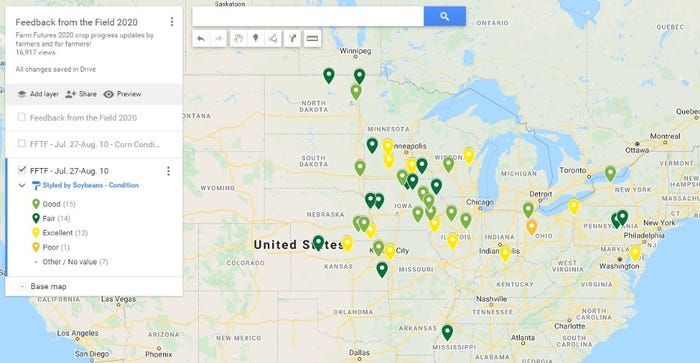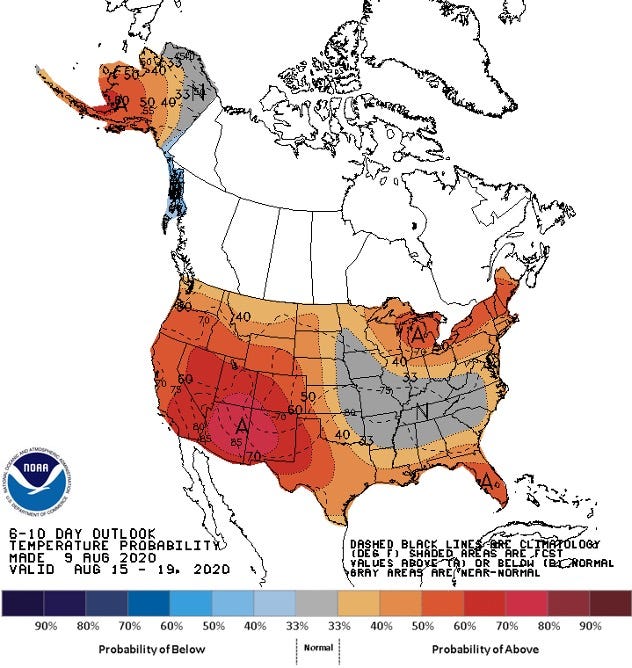
Editor’s note: As of this morning, we had received very few responses from farmers suffering damage from yesterday’s derecho wind events across the Midwest. We will highlight those responses in next week’s Feedback from the Field Roundup, which will inevitably feature declining crop conditions.
Responses are updated daily on our interactive FFTF Google map if you are curious to see real-time information updates. Share your feedback here. Our thoughts are with those in the Midwest who suffered crop and property damage yesterday. – JH
Corn suffers amid increasingly dry conditions
Increasingly dry weather in the nation’s top corn-producing state, Iowa, led a 1% decrease in weekly corn crop ratings in the latest Crop Progress report. Yesterday’s report found 72% of U.S. corn to be in good to excellent condition for the week ending August 9.
Moderate rainfall and cooler temperatures across the Midwest last week helped ease dry conditions in the Eastern Corn Belt. A western Illinois farmer predicts that 2020 corn yields will be “pretty comparable to 2017 but 20 bu/acre less than 2018. We had some replant because of early planting and cold weather.”
But increasing dryness in the Upper Mississippi River Valley contributed to the decline in corn production. In Iowa alone, good to excellent ratings dropped 4% from the previous week to 73% good to excellent as of Sunday.
“We will need rain soon to finish the crop,” a central Wisconsin farmer fretted. The widespread dryness led an East Central Pennsylvania farmer to echo the sentiment, stating, “We have been very dry for the month of June and July.”
But yield prospects remain high despite a dry growing season as strong growing degree days last week allowed maturation to progress at a quicker rate than a week ago. Pollination is nearing a close with 97% of the crop silking as of August 9. About 59% of the crop has reached the dough stage, up from 39% a week ago and 7% ahead of the five-year average.
“The corn crop maturity appears to be advancing at a rapid rate. At the current rate of GDD's the harvest could be on the early side,” a Central Minnesota Farm Futures reader point out. In the first week of reporting on denting progress, 11% of the crop was dented compared to 12% for the five-year average.
But it may be the last week USDA reports such high crop conditions after Derecho winds tore through the Midwest yesterday. Gusts as high as 100 mph left a path of damage more severe than a tornado across eastern Nebraska, Iowa, Wisconsin, and northern Illinois yesterday as the winds moved east into Indiana, Michigan, and Ohio last night.
While yesterday’s storm system dashed record yield hopes for many growers in the Midwest, optimism remains for farmers in areas unaffected by hurricane-force winds. “Everything that can be seen looks excellent,” reported a Central Illinois grower. “However, there were a lot of holes replanted from rains and in many cases much more than just holes were replanted. Yields in those spots can be good but not record setters. Bottom line it will be good, but in my opinion not a record setter for the bottom-line numbers. There will be many individuals with record setting yields, in my opinion, though.”
Soybean ratings upgraded despite dry weather
The U.S. soybean crop continues to thrive despite early planting challenges. Weekly good to excellent condition ratings improved 1% from last week’s Crop Progress report to 74% as of August 9. Moderate temperatures and scattered rainfall east of the Mississippi River last week supported rapid crop development.
A Farm Futures reader from Western Missouri encapsulated improving conditions perfectly in his Feedback from the Field response. “We got all our beans planted timely and got an excellent stand,” the grower stated. “Then we had a dry spell which forced the tap routes to go down looking for moisture. Last week we got 6 inches of rain which got the topsoil saturated. They are best beans I’ve had in the last two years.”

The crop continues to withstand dry conditions better than corn, but rains will be needed in the coming weeks to aid maturation. “Beans have a better chance for record yields than corn as long as conditions remain favorable in August and September,” a Central Illinois farmer pointed out. “There could still be a lot of pods aborted if it doesn't keep raining.”
Growers across the country echoed the sentiment. “Need more rain to fill pods,” a Northeastern Ohio grower lamented. “Many soybean fields in our area are showing moisture stress with yield potential already backing off optimum levels,” said a Northern Iowa farmer.
Blooming progress remained 3% ahead of the five-year average, with 92% of U.S. soybeans bloomed as of Sunday. The crop will likely finish blooming in most areas this week.
Pod setting progress increased rapidly from last week, rising 16% on the week to 75% complete as of August 9, well ahead of the five-year average of 68% for the same time period. “The soybean plant pod clusters very healthy and exhibiting many 3 bean pods with 4 bean pods not unusual,” said a Central Minnesota FFTF respondent.
Declining spring wheat conditions unlikely to impact yields
The U.S. winter wheat harvest clocked in at 90% complete for the week ending August 9 according to yesterday’s weekly Crop Progress report from USDA. Soft red winter wheat yields are largely expected to be slightly higher than 2019 yields, but that may not be the case for all growers.
“Fields looked excellent, but yield was disappointing,” said a grower in Northeast Ohio. A Maryland farmer echoed the sentiment, stating “frost damage really hurt yields you can do everything perfectly, but you can't beat mother nature.” But some had more luck. A Central Wisconsin farmer reported “great yields. Over a ton of straw per acre.”
With soft red winter wheat harvest in the Midwest complete for the year, farmers in the Northern U.S. are scrambling to finish up hard red winter wheat harvest. Overall HRW harvest progress is a little over 80% complete as favorable harvest conditions in the North continue to fuel a rapid harvest pace.
While many areas of the Southern Plains experienced abnormal dryness this year, HRW yields were supported by rain in other areas of the Plains. A North Central Kansas farmer chalked up an “unusual amount of summer rain for our location,” as a reason for strong test weights. Hot weather has favored increasing protein levels in Montana, Washington, and Oregon. Test weights are also projected to come in at above average levels from South Dakota to Idaho.
A slow start to the growing season after spring rains has yet to derail soft white wheat harvest in the Northern U.S., with over 25% of the crop harvested as of last Friday. A Northwestern Minnesota grower bemoaned the spring rains and cool early temperatures, sharing, “17 inches of rain in three weeks is too much. [Our spring wheat crop was] 40% drowned out.” About 15% of the total U.S. spring wheat crop has been harvested, up from 5% a week ago.
Warm and dry weather across the Northern U.S. last week eroded spring wheat conditions by 4% to 69% good to excellent as of Sunday. But it likely matters little as harvest progresses across the north. Yields have already been forecasted above average and rising temperatures will help improve protein levels in the maturing crop.
Toasty in the West, Mild in the East
Temperatures east of the Mississippi River will moderate closer to normal later this week. There is a 33%-40% probability of above average rainfall will accompany cooler temperatures in the Eastern Corn Belt over the weekend and early into next week.

But a different story will likely play out west of the Mississippi. Above average temperatures will persist along the Plains and probabilities of below average rainfall range between 33% - 50% for between August 15-19.

Hot and dry conditions in the Plains will continue next week while the Eastern Corn Belt maintains higher chances of moderate temperatures and above average rainfall. The updated forecasts could help to relieve dry conditions in Ohio and Pennsylvania, though Eastern Iowa and the High Plains will likely continue to battle increasingly severe drought conditions.

Follow along with the season:
Feedback from the Field Roundup: Week ending August 2, 2020 - Wheat harvest rolls on in the Northern U.S.
Feedback from the Field Roundup – Week ending July 26, 2020 - Improved corn conditions offset drought, wind damage.
Feedback from the Field – Week ending July 19, 2020 - Crops withstand the heat while pastures and rangeland suffer lowest ratings since 2012.
Feedback from the Field: July 7, 2020 - Crops stand up to hot weather – for now.
Feedback from the Field: June 30, 2020 - Despite strong ratings, the corn crop may face challenges during silking process.
Feedback From The Field: June 23, 2020 - Readers report solid corn and soybean crop quality so far this year.
About the Author(s)
You May Also Like






